
Six imperatives for chief strategy officers in health care Leading the charge in health care transformation
11 minute read
07 November 2019
As the health care industry moves toward a future dominated by consumer-driven change, emerging technologies, and evolving regulation, the strategy leader can play a pivotal role in navigating stormy waters.
Executive summary
It’s the morning of the monthly board meeting. The strategy leader reviews the latest list of potential technology and community partners to assess opportunities and execute the organization’s strategies. The strategy team, which is well-connected to important thinkers throughout the organization, has gathered that list. At the lunch-time board meeting, the strategy leader recommends new businesses and investments to build new capabilities linking to long-term strategic priorities that have a broader impact on their consumers’ health. Over coffee in the afternoon, the strategy leader has a huddle with the CIO to discuss the latest technology investments and ensure strategic alignment. At the end of the day, the strategy leader’s out-of-the-box thinking and strong connection with the CEO, C-Suite, and the broader organization help steer the organization toward the future.
Learn more
Learn more about the future of health
Explore the Health care collection
Subscribe to receive the latest from Deloitte Insights
Download the Deloitte Insights and Dow Jones app
This may sound like a dream sequence for a typical health care chief strategy officer. But strategy leaders play a critical role in their organization and days like this should be the goal as health care faces a tsunami of change. While many leaders of incumbent organizations can see coming change, we argue that there is no one better positioned than the strategy leaders at these organizations to lead the charge in addressing these changes. The “bat signal” is on for you, strategy leaders.
Strategy leadership is vital for the future of health care organizations. They help prepare for changing consumer expectations, embrace emerging technologies, stay current amid evolving regulations, understand factors that impact health, and compete with both traditional players and new entrants. As this tsunami of change confronts health care organizations, the strategy leader should be interpreting the patterns and trends—both inside and outside the industry. There is now even greater opportunity for the strategy leader to take a lead role in the industry’s transformation.
What role are strategy leaders currently playing to help their organizations navigate toward a changing future? Is there a way to enhance the role’s impact on preparing the organization to weather change and disruption? To answer these questions and others, the Deloitte Center for Health Solutions surveyed 63 health care strategy leaders (chief strategy officers and EVP/VPs of strategy and planning) from health systems and health plans and interviewed another 10.
Our research finds that health care strategy leaders see transformation coming from multiple players and directions. Surveyed respondents told us that top sources of concern are:
- Competition from traditional and new entrants (57 percent)
- Evolving consumer demands (56 percent)
Health care chief strategy officers will need new focus, authority, and scope to their roles to help their organizations transform to succeed in the future of health. But at the same time, these leaders are juggling many competing priorities. While most surveyed strategy leaders say their highest priority is helping shape their organization’s long-term strategy, most also say they spend “the least” amount of time actually working on this priority.
Our interviews with strategy leaders found a disparity among organizations in terms of preparing for tomorrow. Some already have a well-defined vision for the future supported by continued investments—including new leadership, technology adoption, and investment in edge businesses (those outside of its core). But many others are still struggling to define their path to tomorrow, putting them at a greater risk for disruption.
How can organizations and strategy leaders stay ahead of it all? To prepare for tomorrow, health care organizations should realize the full potential of the strategy leader role. To make their organizations and roles as effective as possible in preparing for the challenges ahead, health care strategy leaders and CEOs should consider the six imperatives shown in figure 1.
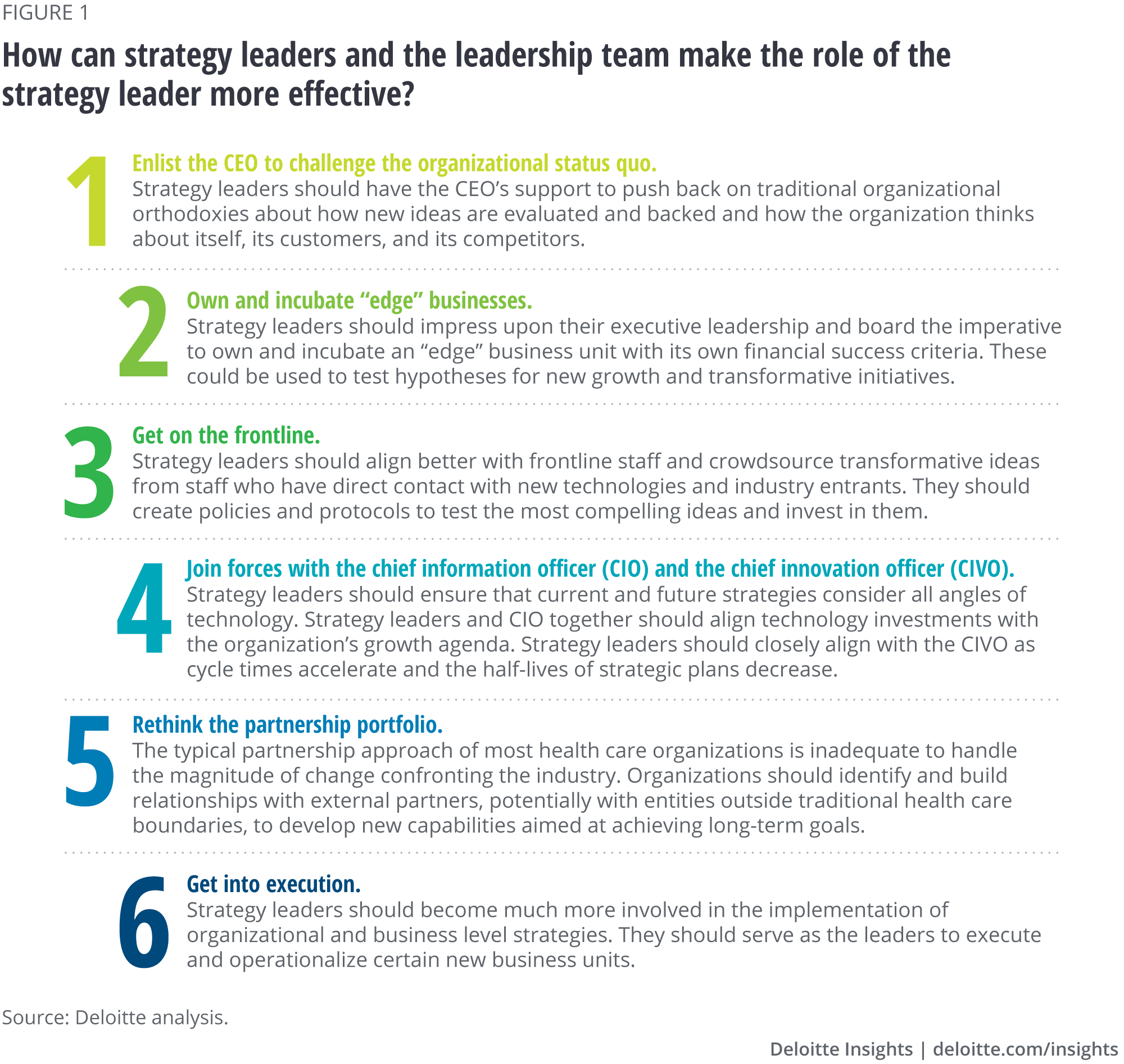
Introduction
As we say in Forces of change: The future of health, the health care system of the future will look very different. By 2040, we expect consumers to be at the center of the health model; the focus to be on health and wellness; virtual monitoring and care delivery to be the norm; and interoperable, always-on data to be available for insights and collaboration. We also expect new entrants to the industry to help drive this transformation by offering customer-friendly, technology-driven solutions to solve for some of the industry’s biggest challenges.
What does this mean for today’s health care companies? Disrupt or be disrupted. Incumbents will need to change or risk displacement by industry disrupters—large technology companies, startups, and retailers included. The entire industry will undergo radical transformation.
Some of these trends are already underway. For example, 20 percent of consumers have used technology to measure and share their medication data with their providers, and 35 percent are interested in engaging with a virtual assistant to identify symptoms and direct them to a physician.1 Also, 27 percent of health care organizations say that they have invested in technologies to automate tasks and processes.2
The Deloitte Center for Health Solutions surveyed 63 strategy leaders (chief strategy officers and EVP/VPs of strategy and planning) at health systems and plans and interviewed another 10 to understand how organizations are reacting to these trends, preparing for tomorrow, and aligning themselves for future transformation. Nearly three-quarters of surveyed participants were from organizations with annual revenue greater than US$1 billion. In addition, Deloitte also held a summit with strategy leaders from health systems and health plans in the fall of 2019 to discuss these topics. Our research findings suggest that many opportunities lie ahead for health care organizations—as well as their strategy leaders.
Research findings
Opportunities exist to evolve the strategy leader role and the organization to prepare for tomorrow.
A tsunami of change–new technologies, regulations, changing consumer expectations, and industry entrants—is fast approaching health care. Our survey and interviews found that strategy leaders at health care organizations must juggle these and other trends.
Industry transformation expected
Strategy leaders agree that the industry will experience major transformation in the next 10 years. Interviewees expect care delivery to change the most across the industry. Consumer demand, new payment models, and alternate sites of care (virtual health, urgent care, and retail clinics) will likely shift care delivery outside of hospitals. And with multiple modalities to access care (in-person, virtually, or on mobile devices), strategy leaders say that incumbent health care organizations will be required to develop new capabilities to deliver an immersive patient experience. Others also pointed to the imminent evolution of health care financing as consumers, employers, and governments are increasingly unable to manage the growing costs of health care.
“As the industry around us evolves, consumers are going to want immediate access to things at their fingertips. If you really want to be successful in this business, you need to tend to what the consumer wants.”—Health system chief strategy officer
Competition has a new look
More than half (57 percent) of those surveyed said greater competition from traditional and new entrants will likely compel their organizations to focus on long-term strategy (figure 2). As incumbent organizations consider their market positions and competition, many are also concerned about their ability to react to consumers’ growing demands.
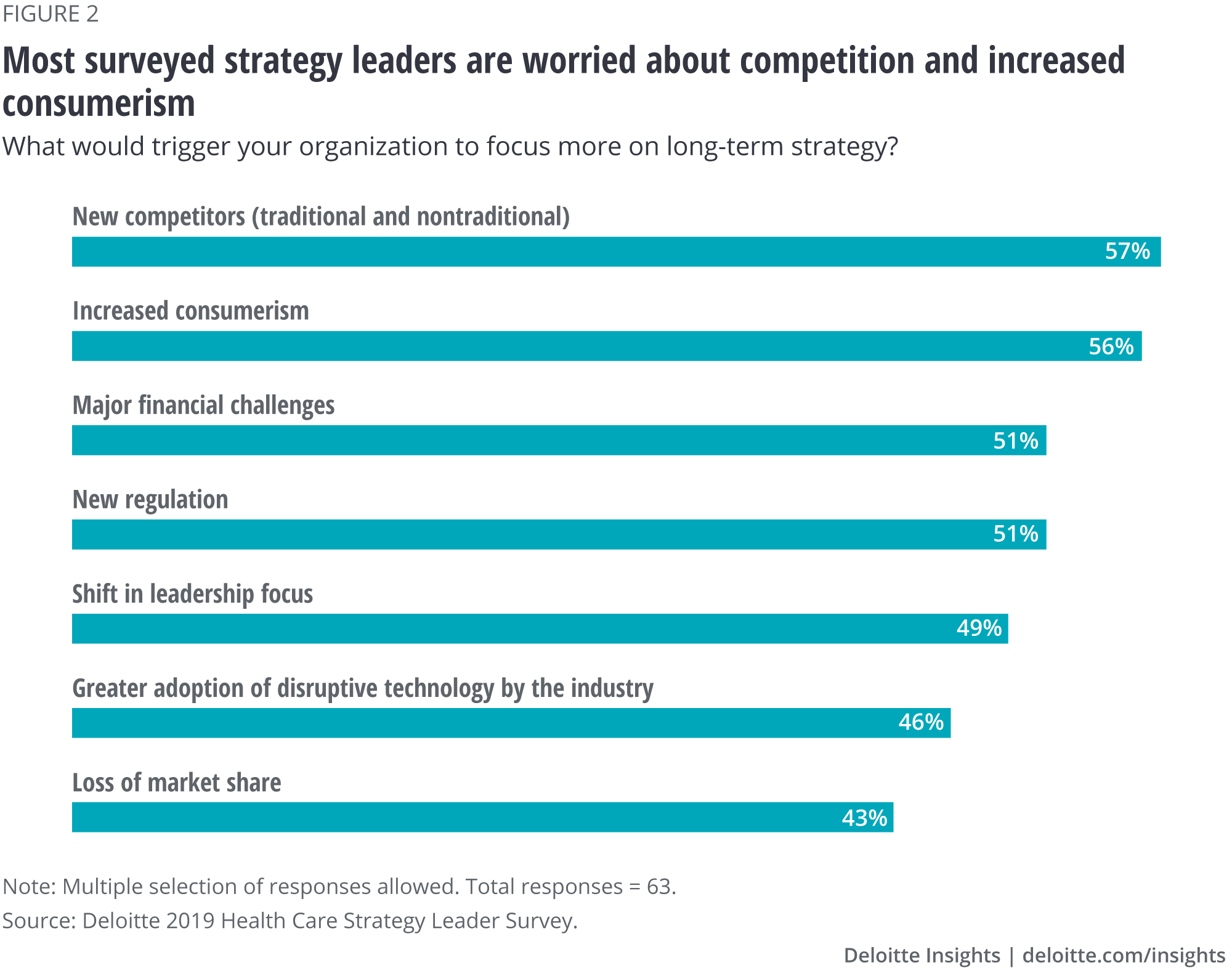
Interviewed leaders discussed how large technology companies, retailers, and startups are entering the industry intending to disrupt incumbents. Some said that technology entrants could make data more liquid, analyzable, and shareable. For now, though, many are adopting a wait-and-watch approach, as they do not perceive these entrants as a major threat to their core business. Many say these entrants are likely to impact only the fringes of health care but not the core—care delivery. Only time can tell what impact they will have on the industry and on incumbents’ businesses.
“I don’t know what to think of their [new entrants to the industry] role yet … We are just sitting around and guessing. We need to have an eye on them and be ready to react.”—Health system chief strategy officer
A more imminent concern among interviewed leaders is competition from incumbent players stepping outside of their core business or retailers entering the industry. Many of them say these competitors have customer-friendly offerings. Many of the top retailers have already built retail clinics in their stores that are competing directly with health systems by offering convenient access to care. Recently, Walmart opened a stand-alone primary care clinic.3
Strategy leaders’ ability to make an impact—on the organization and the industry—is often limited
The world of health care strategy leaders can be stressful. Their role is often limited in scope and oversight, which prevents them from significantly impacting strategy execution. Juggling multiple organizational priorities also makes it difficult for them to focus on preparing for tomorrow.
When asked to rank organizational priorities, surveyed strategy leaders rank overall performance (including containing costs and sustaining margins) the top priority today (75 percent) and in the future (86 percent). Beyond that, however, strategy leaders appear to be handing over other priorities to their future selves. While transforming clinical and business decision-making capabilities through digital technology adoption and shifting into value-based care is the greater priority for the future, strategy leaders should speed up those efforts today.
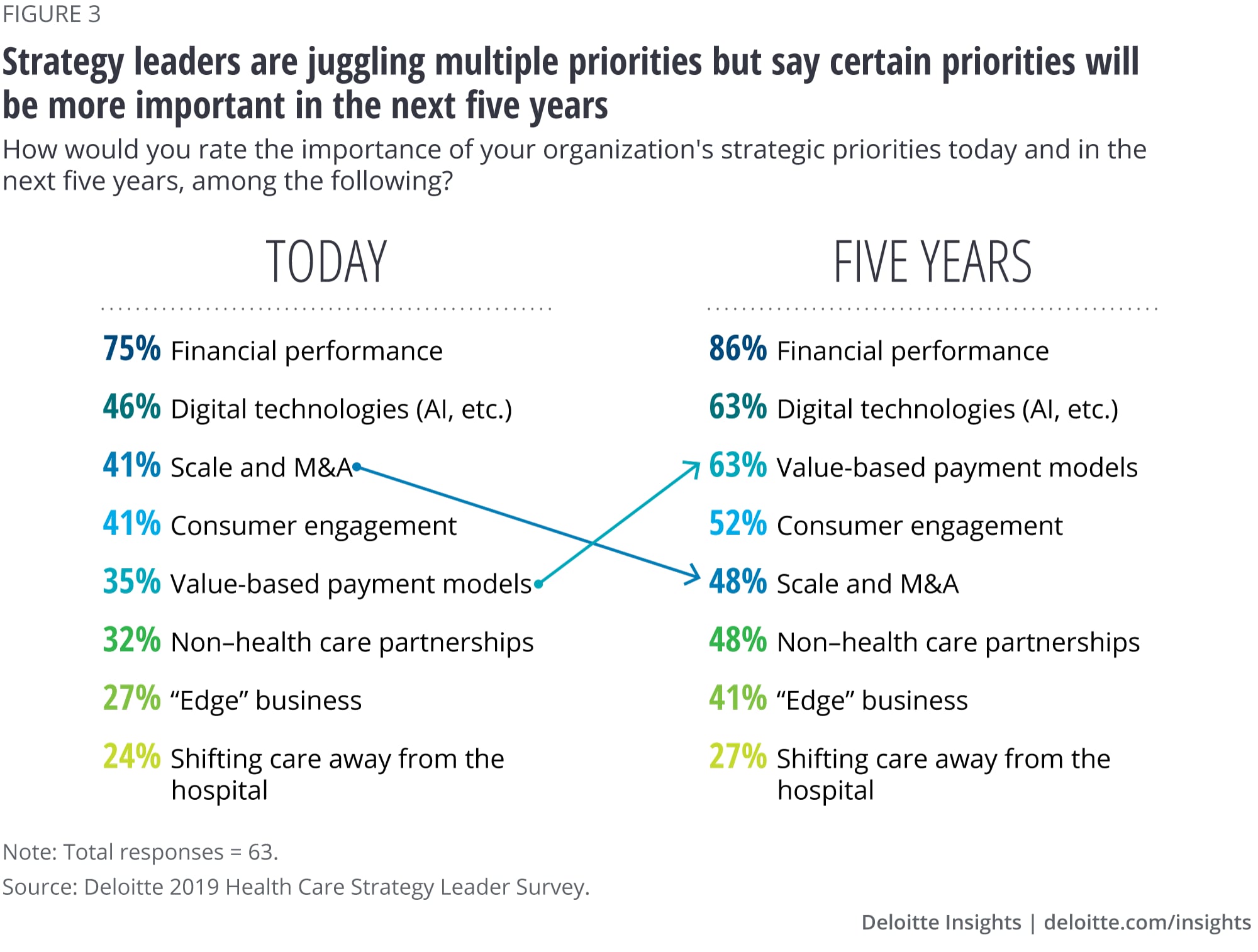
Some are walking the walk or talking the talk, others don’t yet have a vision
Through our interviews, we analyzed how prepared each organization is for the future, based on its defined strategies and investments. While not an analysis of the entire industry, it is representative of the reality at most organizations today. Some of the organizations we interviewed are walking the walk—they have a defined vision for the future, supported by investments—including new leadership, technology adoption, and edge businesses (those outside of its core). Others are talking the talk—they have a clear vision for the future but are yet to begin execution. Finally, another set of organizations is still determining the future path.
In figure 4, we plotted the interviewed organizations along a spectrum to represent their preparedness for future transformation. Those that fall in the upper right quadrant—walking the walk—have made transformation a high priority and have strong investment strategies to support it. Those in the bottom left quadrant are neither prioritizing nor investing in strategies for future transformation.
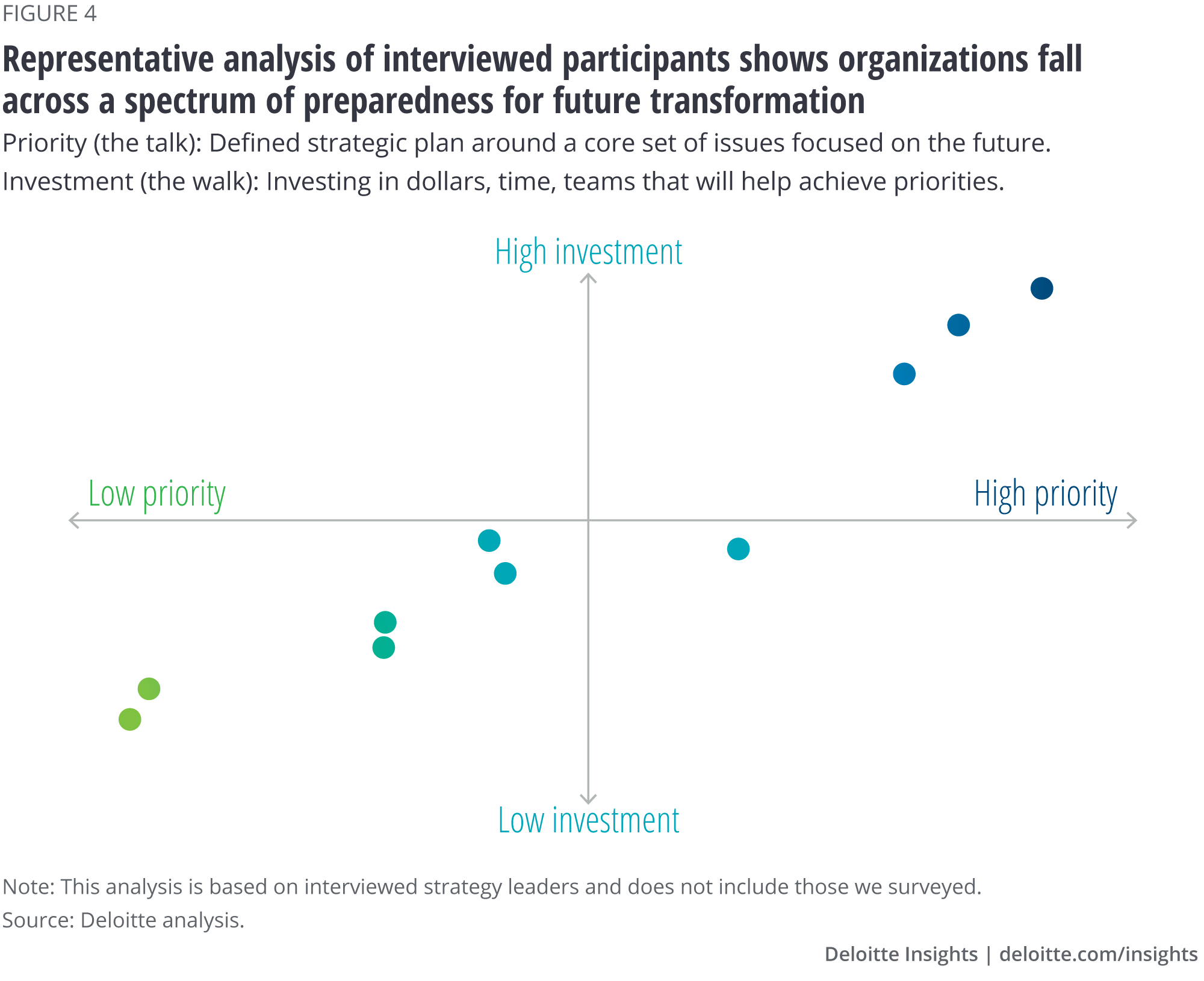
Organizations gave many reasons for not walking the walk during our interviews—they face competing priorities, scarce resources, and a lack of clarity around where to invest. But one thing is clear: Organizations that have yet to define their future strategy or take steps to execute on it may be at risk of disruption. However, they do have the opportunity today to get started.
Our research also revealed a few early movers acting to transform their business (see sidebar, “Early movers transforming today for tomorrow”).
Early movers transforming today for tomorrow
Some leading companies are exploring ways to innovate today and reposition themselves for the future. Building new revenue streams and “edge businesses” outside the core of care delivery and financing is one common pathway. A few even expect new revenue streams and/or edge businesses to account for a significant share of overall revenue in the next decade. Others are hiring talent from other industries to bring in greater consumer-centricity or are developing new technological capabilities. All result in the companies taking action toward the future ahead of their peers and competitors.
Providence St. Joseph Health (PSJH) is positioning itself with new technology capabilities and building new revenue streams through acquisitions. It recently acquired Bluetree Network to help other health systems optimize their electronic health record (EHR) investments.4 PSJH also acquired a blockchain company with a claims processing platform that simplifies financial transactions between payers and providers and reduces administrative burden.5
Humana has launched “Humana at Home” to provide in-home, behavioral, and palliative care for chronically ill patients.6 In 2019, Humana launched Studio H to develop digital health apps and virtual care for care coordination.7 It also joined the Consumer Technology Association (CTA), a diverse group of companies (including Microsoft and Walgreens) aiming to use consumer technology to lower health care costs and drive better outcomes. Humana is the first health plan to join CTA.
Anthem is transforming itself into a digital platform company, hiring talent from technology companies to lead AI and health data efforts.8 It is beginning to rely on AI as the foundation for business transformation and also for AI to power the development of consumer friendly solutions to address whole person health and to simplify healthcare.
Mayo Clinic is testing AI algorithms to detect and diagnose arterial defibrillation from EKG readouts, and invested US$30 million in a startup that uses AI to help physicians detect early signs of stroke.9
Cleveland Clinic is investing in a center for advanced AI to build machine learning algorithms for diagnosis, treatment decision-making, and predicting patient outcomes.10
Sanford Health has built a high-margin retail presence with 140 weight-loss storefronts. It plans to open 350 more stores in the next few years.11
Challenges to a longer-term focus
Surveyed strategy leaders say they spend most of their time on activities that are not their top priorities. While most say their topmost priority is helping shape their organization’s long-term strategy, most also say they spend the least amount of their time (among all the other activities we asked about) actually working on this priority (figure 5).
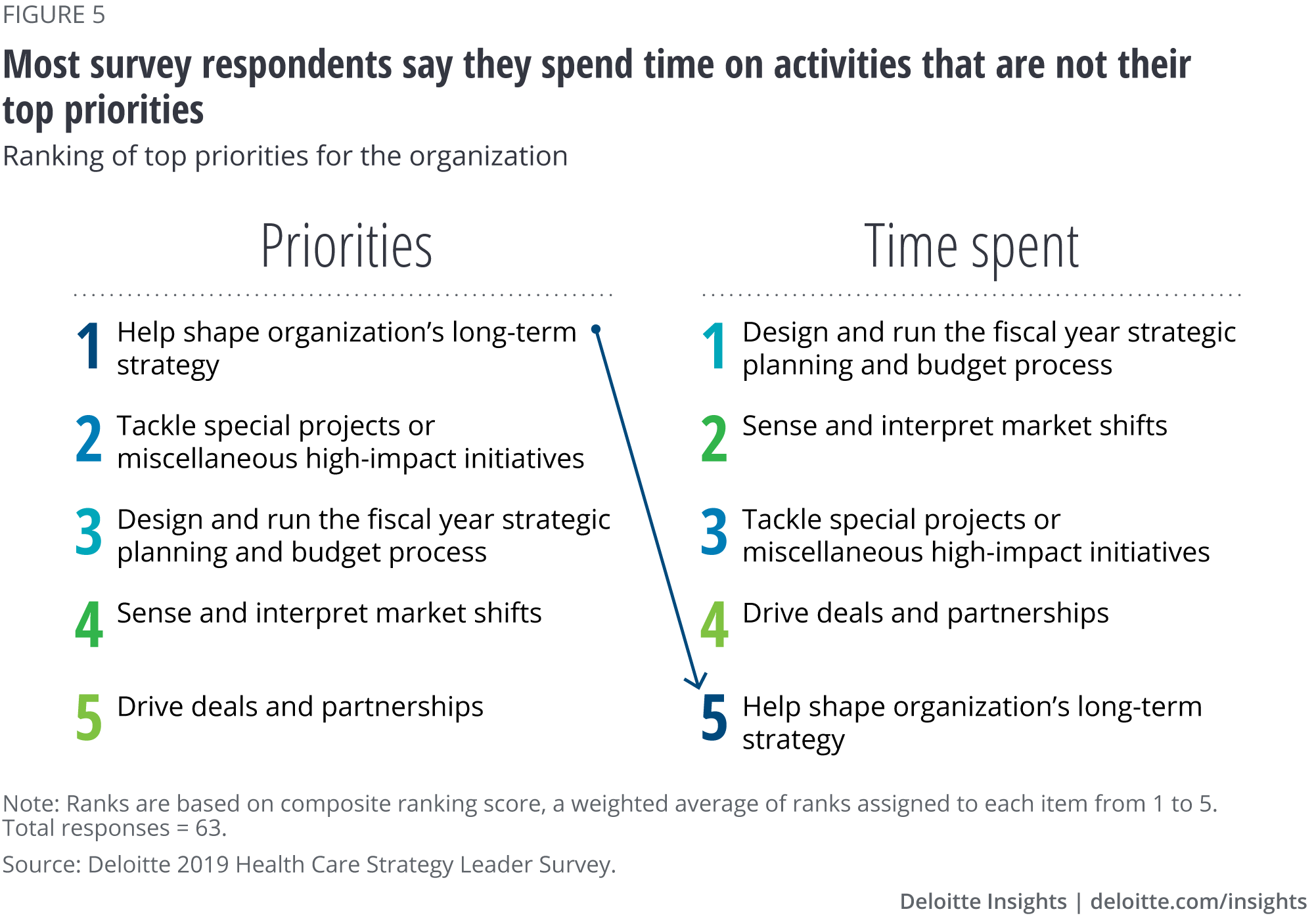
How can strategy leaders make a greater impact?
Today the role of the strategy leader is already central to the future of health care organizations. The approaching tsunami of change and disruption presents multiple opportunities for these leaders to further the impact and influence their role has on organizational transformation. Strategy leaders, CEOs, and the organization as a whole should consider the following six imperatives:
1. Enlist the CEO to challenge the organizational status quo.
- Strategy leaders should have the CEO’s support to push back on organizational orthodoxies on how new ideas are evaluated and backed and the way in which the organization thinks about itself, its customers, and its competitors.
2. Own and incubate “edge” businesses.
- Strategy leaders should impress upon their executive leadership and board the imperative to own and incubate an “edge” business unit to test hypotheses for new growth and transformative initiatives.
- These edge businesses should have different financial criteria for decision-making—thinking that is unbiased against innovation. Emphasis should be placed on expected value over discounted cash flow.
3. Get on the frontline.
- Strategy leaders should align better with frontline staff who have direct contact with new technologies and entrants in the industry and crowdsource transformative ideas. They should create policies and protocols to test the most compelling ideas and invest in them.
- They should also work closely with frontline managers to anticipate trends and convene with leaders from across divisions to discuss opportunities for innovation.
4. Join forces with the CIO and the CIVO.
- Strategy leaders and CIOs can work together on the overall technology strategy—from underpinning future strategies with the latest and greatest to the implications of today’s technology investments on future strategies.
- The CIO should be at the front end of technology efforts and develop deeper relationships with the organization’s core technology vendors.
- Strategy leaders should closely align with the CIVO to put innovation at the forefront of all organizational strategies.
5. Rethink the partnership portfolio.
- Organizations should identify and build relationships with external partners, potentially entities outside of traditional health care boundaries.
- Build partnerships with large technology companies through consortiums, industry groups to build the capabilities (data, platforms, and digital tools) to achieve long-term goals through innovation.
- Strategy leaders also should partner with community organizations and state and local governments to test new models of care delivery and coordination.
- Create relationships with community partners to better impact the health of the community and social determinants of health.
6. Get into execution.
- Strategy leaders should become much more involved in implementing organizational- and business-level strategies. This would include serving as the leader to execute and operationalize certain new business units.
- Strategy leaders should impress on their leadership and board the necessity of having a pool of resources dedicated to innovation. This could include teams—or funds—to partner with thought leaders who can help with sensing and scanning.
- Lastly, strategy leaders should encourage all functions to adopt the fundamental priorities of the strategy plan as their own. Doing this can require organizations to shift away from annual planning to future transformation by creating both short- and long-term vision and strategy. Every decision and investment should tie into the organization’s broader, long-term strategy and overall business goals.
Leading organizations could go a step beyond these strategies to ensure they remain relevant in a changing future. For one, they should identify needed capabilities that require external partners, including technology, retail, and other leading health care organizations. In addition, building a team of “out-of-the-box” thinkers—from bringing in experts from non–health care industries to influencing the board membership and composition—could bring new ideas and perspectives to light.
Organizational transformation requires the strategy leader to play the role of the “canary in the coal mine” and identify previously unthought of risks, trends, and challenges. By shifting the focus toward a long-term future, strategy leaders can help their organizations innovate.
© 2021. See Terms of Use for more information.
Explore the Future of Health
-
The future of health Collection
-
The health plan of tomorrow Article5 years ago
-
What will health look like in 2040? Video5 years ago
-
Forces of change in health care Article5 years ago
-
Winning in the future of medtech Article5 years ago
-
The future of aging Article5 years ago












